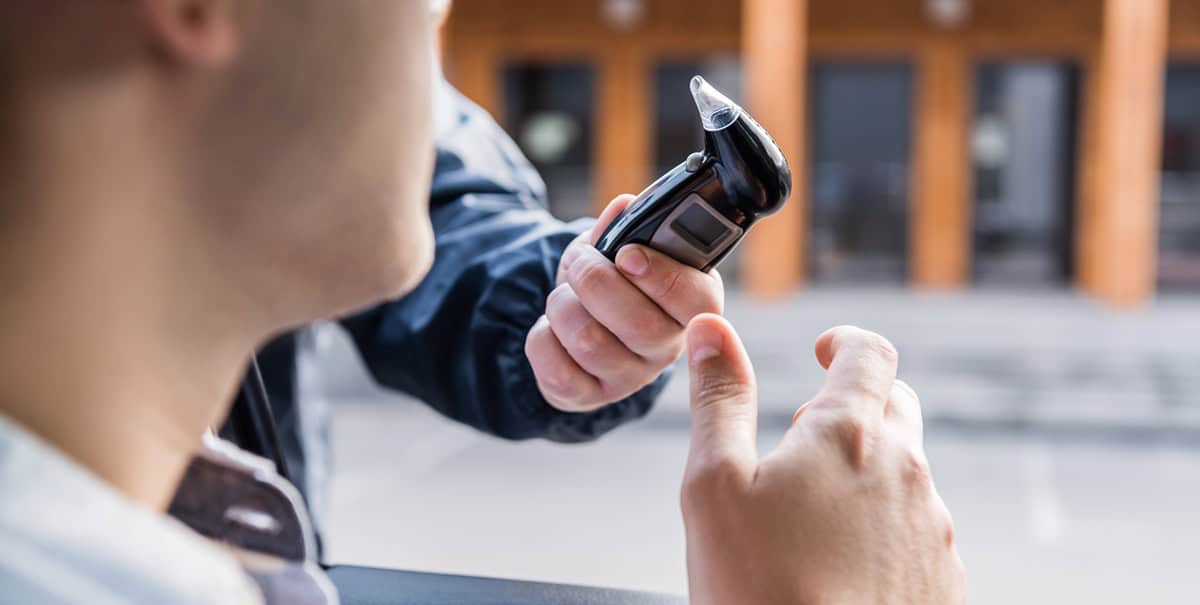Arizona has some of the strictest DUI laws in the country. It’s important to know the legal limits and how DUI is defined under Arizona law, especially ARS §28-1381, which is the primary DUI statute. Under Arizona law, you can be charged with DUI in several ways:
- Presumed DUI – BAC 0.08% or higher
- “Impaired to the slightest degree” – below 0.08%
- Commercial drivers – BAC 0.04% or higher
- Underage Drivers – 0.00% tolerance
- Drug DUI – Marijuana, Prescription & Non-Prescription
- Extreme and Super Extreme DUI
- Aggravated DUI (Felony)
- “Actual physical control”
- Real-world BAC examples
- Need a DUI Lawyer? Call Shah Law Firm Today
Presumed DUI – BAC 0.08% or higher
If you have a BAC of 0.08% or above, you are per se considered driving under the influence (for non-commercial drivers age 21 or over).
Arizona law (ARS 28-1381(A)(2)) makes it unlawful to drive or be in actual physical control of a vehicle if your BAC is 0.08% or more within two hours of driving.
In practice, this means if you take a breath or blood test and it comes out 0.08 or above, that alone can establish the DUI offense (assuming the test is done within two hours of when you were driving).
The 0.08% BAC limit is the same used in all 50 states, with the exception of Utah, where it is 0.05%. For most people, reaching 0.08% would require more than one drink – typically, 2 to 3 drinks in a short period could get an average adult to 0.08%, but as we discussed, it varies by person.
Note: The legal BAC limit for Arizona drivers with a CDL (commercial driver’s license) is .04%.
“Impaired to the slightest degree” – below 0.08%
Arizona is unique in that you can be charged with DUI even if your BAC is below 0.08%. ARS 28-1381(A)(1) makes it illegal to drive “while under the influence of intoxicating liquor… if the person is impaired to the slightest degree”. In plain English, if an officer believes your driving was affected even a little bit by alcohol (or drugs), you can be arrested for DUI, even if your chemical test is under the usual limit.
Arizona courts interpret “impaired to the slightest degree” literally – any impairment is enough.
For example, if your BAC was 0.05% for example, but you were weaving in your lane and exhibited signs of intoxication, you could be convicted under this provision. (For reference, Arizona law says if your BAC is 0.05% or below, it’s presumed you are not under the influence; 0.08% or above, it’s presumed you are between 0.05 and 0.08, it’s left open to interpretation. But that presumption can be rebutted by other evidence of impairment.)
The key takeaway: Don’t assume you’re “safe” to drive just because you’re under 0.08%. Arizona can still charge you, and people do get convicted for DUI under the slightest degree clause when their BAC is 0.06 or 0.07 if other impairment evidence exists.
Commercial drivers – BAC 0.04% or higher
If you hold a commercial driver’s license (CDL) and you’re driving a commercial vehicle, the legal BAC limit is lower. ARS 28-1381(A)(4) sets a 0.04% BAC limit for commercial vehicle drivers. This is in line with federal DOT standards. Commercial drivers (like truck drivers) can face DUI charges at 0.04% BAC.
Note that if a CDL holder is driving a personal car, the 0.08 limit applies; however, a DUI conviction will still affect their CDL status.
Underage Drivers – 0.00% tolerance
Arizona has a zero-tolerance law for underage drinking and driving. ARS 4-244(34) makes it illegal for anyone under 21 to drive with any alcohol in their body. In other words, if you’re under 21, any measurable BAC (0.01% or above) could lead to an “underage DUI” charge, even if you are not impaired. This is separate from standard DUI; minors can actually be charged under both the underage drinking law and the regular DUI laws if they are impaired.
But the bottom line is, if you’re underage, you cannot have any alcohol in your system while driving in Arizona – one beer could get your license suspended.
Drug DUI – Marijuana, Prescription & Non-Prescription
Although this article focuses on alcohol, be aware that Arizona also criminalizes driving under the influence of drugs (illegal or even legal meds if they impair you). ARS 28-1381(A)(3) says it’s illegal to drive with any illegal drug or its metabolite in your body. And ARS 28-1381(A)(1) (the slightest degree section) applies to drugs as well.
There’s no “legal limit” for drugs like there is for alcohol – essentially zero tolerance for illegal drugs.
Prescription drugs can lead to a DUI if they impair you and you didn’t use them as prescribed.
Extreme and Super Extreme DUI
Arizona law has enhanced DUI categories for very high BAC levels. These come with tougher penalties (which we’ll detail in the penalties section).
▶ Extreme DUI
If your BAC is 0.15% or higher, but below 0.20, Arizona classifies this as “Extreme DUI” under ARS 28-1382(A)(1). It’s still a misdemeanor for a first or second offense, but penalties are more severe than a standard DUI.
▶ Super Extreme DUI
If your BAC is 0.20% or higher, Arizona calls this “Super Extreme DUI” (or sometimes “Supreme Extreme DUI”) under ARS 28-1382(A)(2). This is the most serious misdemeanor DUI category, with the harshest misdemeanor penalties.
For context, a 0.20% BAC is two and a half times the basic legal limit – a very high alcohol level where obvious impairment would be expected.
It’s worth noting that at such high BAC levels, a driver will face mandatory jail time even on a first offense and large fines (see penalty table below). Arizona created these categories to deter high-BAC offenses specifically – they recognized that drivers with extremely high BAC pose an even greater risk.
Aggravated DUI (Felony)
Arizona bumps certain DUIs up to felonies, called Aggravated DUI (covered by ARS 28-1383).
Situations that make a DUI “aggravated” include: a third DUI offense within 84 months (7 years), driving on a suspended/revoked license when DUI, DUI with a child under 15 in the car, or DUI while ordered to use an ignition interlock.
An aggravated DUI is a felony charge, meaning prison time is on the table. We will cover penalties for this as well. But understand that even a first-time DUI can become a felony if, for example, you had a minor passenger with you (that’s a class 6 felony in Arizona). Most commonly, aggravated DUI refers to a third offense (which is a class 4 felony) or DUI on a suspended license (also class 4).
“Actual physical control”
Note that Arizona’s DUI laws apply to being in “actual physical control” of a vehicle, not just driving on the road.
This means you can get a DUI even if you were not caught driving the car.
For instance, if you’re found passed out in the driver’s seat with the keys in the ignition (even if the car is parked), you might be considered in actual physical control of the vehicle.
Each case depends on circumstances (courts consider factors like whether the vehicle was running, where the keys were, etc.), but just know that sitting in your car while intoxicated can still lead to a DUI charge in Arizona.
Real-world BAC examples
To illustrate how BAC can vary and why these laws matter, let’s look at a couple of scenarios:
▶ Example 1
A 180-pound man goes out and has four beers in one hour. According to BAC estimates, four standard drinks for a 180 lb. male would yield roughly a 0.08% BAC initially. But since an hour has passed, we subtract some for metabolism. After an hour, his BAC might be around 0.068% (approximately) – just under the legal 0.08 limit.
In fact, one chart shows an example: a 180 lb. man, 4 drinks in an hour, estimated BAC ~0.083 before metabolism, minus 0.015 for an hour of elimination, comes out to ~0.068. In this case, he might think he’s okay to drive because he’s under 0.08. Indeed, legally he wouldn’t be automatically over the limit. However, at ~0.068 he could still exhibit impairment (reaction time slowed, etc.). If he were pulled over for swerving, he could still be charged with DUI (slightest degree). And importantly, if he had that fifth beer, he’d almost certainly be over 0.08 and in definite DUI territory.
▶ Example 2
A 120-pound woman has three glasses of wine over two hours at a dinner. Using BAC estimates for a 120 lb. female, three drinks in 2 hours might result in roughly a BAC of about 0.078%. One reference example shows a 120-pound woman consuming 3 drinks over 2 hours, reaching approximately 0.114% before metabolism. After 2 hours (subtracting 0.018% per hour for women), her BAC would be about 0.078%. That is just under the legal limit of 0.08%. She might feel only mildly tipsy. However, someone that size could easily cross the 0.08 threshold with just a little more alcohol – even a fourth small drink could push her well over.
If she drove home at 0.078, she’d technically be under 0.08, but if an officer observed poor driving or other signs of impairment, she could still face a DUI charge. And if she waited only a short time after the last drink to drive, her BAC could still have been rising (more on “rising BAC” later) and actually hit 0.08 or higher by the time of a test.
▶ Example 3 – Rising BAC scenario
Imagine a person takes three shots in quick succession, then immediately gets in the car to drive. When they started the car, perhaps their BAC hadn’t fully peaked yet (because alcohol takes 30-90 minutes to absorb fully). They get pulled over 20 minutes later. By the time they do a breath or blood test, their BAC might have climbed to, say, 0.10%. It is possible that at the exact time of driving, it was lower (maybe 0.07 or 0.08, just at the threshold), but by test time, it’s higher.
Arizona’s law accounts for BAC within two hours of driving, so that person can still be charged (and this scenario is common – it’s known as the “rising BAC” issue). We’ll discuss later as a defense strategy how a lawyer might argue the BAC was rising and the person wasn’t actually over the limit while driving, but as you can see, real-world timing can complicate things.
These examples demonstrate that BAC results vary from individual to individual and situation to situation. Two people can drink the same amount and have different outcomes – one might be under the limit, the other over. That’s why Arizona’s approach is both a “number” (0.08) and an “impairment” standard.
The safest course is, of course, not to drive at all after drinking. But it’s important to understand these factors, especially if you’re dealing with a DUI charge.
Need a DUI Lawyer? Call Shah Law Firm Today
 Arizona enforces some of the strictest DUI penalties in the country, yet every charge is defensible when approached with skill and urgency. Shah Law Firm dedicates its practice to helping motorists challenge drunk driving allegations throughout Maricopa County. Attorney Arja Shah brings nearly two decades of courtroom experience to each client she represents.
Arizona enforces some of the strictest DUI penalties in the country, yet every charge is defensible when approached with skill and urgency. Shah Law Firm dedicates its practice to helping motorists challenge drunk driving allegations throughout Maricopa County. Attorney Arja Shah brings nearly two decades of courtroom experience to each client she represents.
A successful defense often starts with the traffic stop itself. Officers must have reasonable suspicion before activating their lights, and any misstep can lead to suppressed evidence. We review dash-cam footage, dispatch logs, and body-cam audio to determine whether the stop was lawful.
Once a stop occurs, testing procedures become the next battleground. Breathalyzers require precise maintenance schedules, blood samples demand proper chain of custody, and field sobriety tests must be given under fair conditions. Arja Shah works with forensic experts to spot irregularities that cast doubt on the readings.
Beyond the science, procedural rights matter. You deserve Miranda warnings at the right time, the chance to consult counsel, and the opportunity to seek an independent blood test. Any violation can weaken the prosecution’s position, sometimes enough to see charges dismissed outright.
Our firm represents clients in Phoenix, Scottsdale, Tempe, Mesa, Chandler, and the wider Valley. We understand how a single conviction can threaten careers, immigration status, and family life, so we advocate for alternatives such as reduced charges, diversion programs, or case dismissal whenever possible.
Call (602) 560-7408 or visit our contact page for a free consultation. Early action lets us request MVD hearings, secure evidence, and create a strategy that protects your license and your future.








